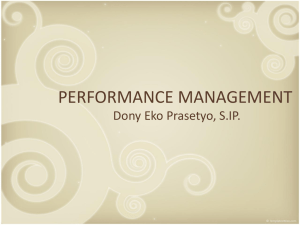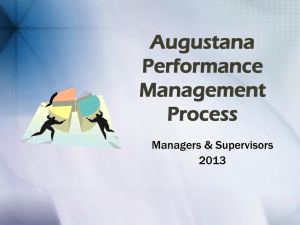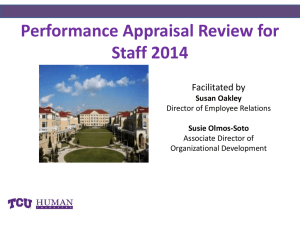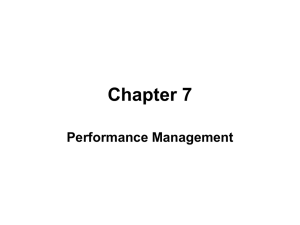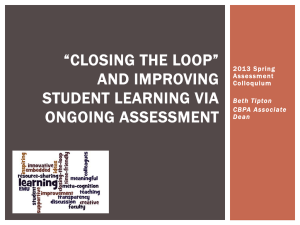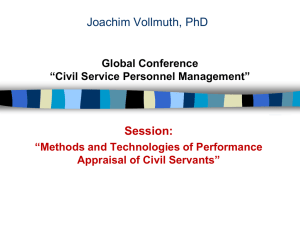09 - Appraisal Requirements for CMMI-ARC
advertisement
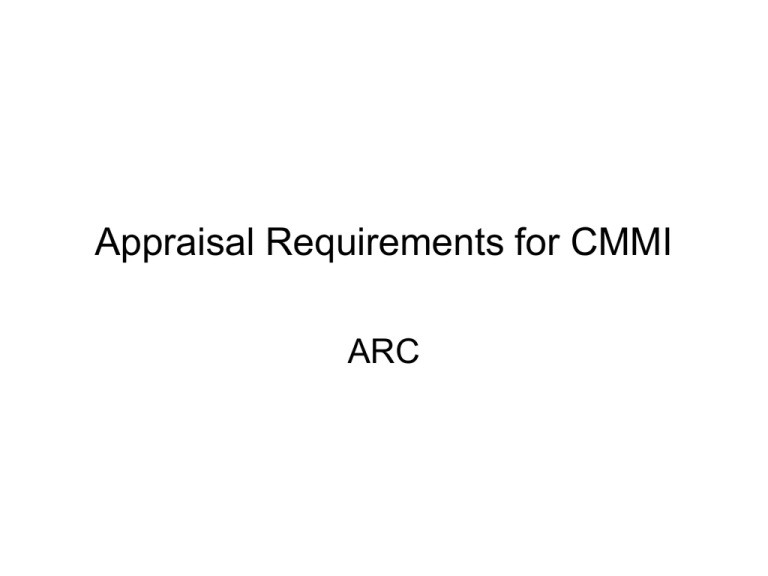
Appraisal Requirements for CMMI ARC Appraisal Requirements for CMMI • The Appraisal Requirements for CMMI® (ARC) consists of a set of high-level design criteria for developing, defining, and using appraisal methods based on CMMI models. Retrospective – SEI Appraisals Generation Method (s) Model (s) Period 0 SEI-assisted Implicit Assessments (SEIAAs) 1987-1992 1 Software Process Assessment (SPA), SCE Implicit/SW-CMM 1988-1994 2 CBA IPI/SCE 3.0 SW-CMM 1994-2005 3 SCAMPI (A) CMMI 2001+ ARC Appraisal Principles • Start with an appraisal reference model. • Use a formalized appraisal process. • Involve senior management as the appraisal sponsor. • Focus the appraisal on the sponsor’s business objectives. • Observe strict confidentiality and non-attribution of data. • Approach the appraisal collaboratively. • Focus on follow-on activities and decision-making based upon the appraisal results. Appraisal Method Classes Comparison of Appraisal Method Classes • Class A – appraisal methods must satisfy all of the ARC requirements, – the only methods considered suitable for providing ratings for benchmarking. – An example of a Class A method is the Standard CMMI Appraisal Method for Process Improvement (SCAMPISM). • Class B – – – – – appraisal methods are required to comply with a subset of the ARC requirements. several requirements of Class A methods are optional for Class B methods. Two types of objective evidence are required for both Class A and B methods. Class B methods do not produce ratings These types of appraisals are recommended for initial assessments in organizations that are just beginning to use CMMI models for process improvement activities. – They also provide a cost-effective means for performing interim assessments and/or capability evaluations between Class A appraisals. • Class C – appraisal methods are required to comply with a subset of the ARC requirements for Class B methods. – Only one of the two types of objective evidence required for Class A methods is required – Validation and corroboration are also optional – These types of appraisals would most likely be used when the need for a “quick look” arises or for periodic self-assessments by projects and organizational support groups. Comparison of Appraisal Method Classes Requirements for CMMI Appraisal Methods (1) • Responsibilities – The method shall define the responsibilities of the appraisal sponsor – The method shall define the responsibilities of the appraisal team leader • Appraisal Method Documentation – The method shall be documented – The method documentation shall provide guidance for: • identifying an appraisal’s purpose, objectives, and constraints; • determining the suitability of the appraisal method relative to the appraisal’s purpose, objectives, and constraints • identifying the scope of the CMMI model(s) to be used for the appraisal • identifying the organizational unit to be appraised • selecting appraisal team members and criteria for qualification, including • an appraisal team leader’s qualification criteria • determining the appropriate size of the appraisal team. For Class A appraisals, the minimum team size is four members; for Class B appraisals, two members; for Class C appraisals, one member. • the roles and responsibilities of appraisal team members. Requirements for CMMI Appraisal Methods (2) – The method documentation shall provide guidance for • addressing the responsibilities of the appraisal sponsor. • addressing the responsibilities of the appraisal team leader. • estimating the resources required to conduct the appraisal (including the amount of time required to conduct an appraisal). • appraisal logistics. • collecting relevant data on the organizational unit and associating the data to the specific and generic practices of the appraisal reference model. • creating findings, including both strengths and weaknesses relative to the appraisal reference model. • protecting the confidentiality of appraisal data and ensuring nonattribution of data contributed by appraisal participants. • recording traceability between the data collected during the appraisal and the findings and/or ratings, • the retention and safekeeping of appraisal records, • compiling and maintaining an appraisal record that supports the appraisal team’s findings and/or ratings Requirements for CMMI Appraisal Methods (3) • Planning and Preparing for the Appraisal – The method shall provide for the preparation of appraisal participants by addressing • • • • • the purpose of the appraisal, the scope of the appraisal, the appraisal approach the roles and responsibilities of participants in the appraisal the schedule of appraisal activities – The method shall provide for the development of the appraisal input prior to the beginning of data collection by the appraisal team. – The method shall require that the appraisal input, and any changes to the appraisal input, shall be agreed to by the sponsor (or the delegated authority) and documented in the appraisal record. – The method shall require the development of an appraisal plan Requirements for CMMI Appraisal Methods (4) • Appraisal Data Collection (Objective Evidence) – The method shall collect data by conducting interviews (e.g., with project leaders, managers, practitioners). – The method shall collect data by reviewing documentation (e.g., organizational policies, instruments, project procedures, and implementationlevel work products). Requirements for CMMI Appraisal Methods (5) • Data Consolidation and Validation – The method shall require • appraisal team consensus when teams are involved in decisions related to determining the validity of findings and establishing ratings. • a mechanism for consolidating the data collected during an appraisal into accurate findings • a mechanism for verifying findings • a minimum set of criteria to be satisfied in order for objective evidence to be considered “corroborated”: • a mechanism for determining that sufficient data has been collected to cover the scope of the appraisal, • (A) a mechanism for consolidating objective evidence into preliminary findings of strengths and weaknesses relative to the appraisal reference model. • (A) The method shall require that appraisal participants be presented with the preliminary findings in order to solicit their responses for validation of the findings’ accuracy and clarity. Requirements for CMMI Appraisal Methods (6) • Rating – The method shall define a rating process – (A) The method shall require that maturity level ratings and/or capability level ratings be based on the definitions of capability levels and maturity levels in the CMMI models. – The method shall rate each specific and generic goal (provided the prerequisites of rating have been met) within the appraisal scope – The method shall rate each process area within the appraisal scope, if requested by the appraisal sponsor, – The method shall rate the maturity level, if requested by the appraisal sponsor Requirements for CMMI Appraisal Methods (7) • Reporting Results – The method shall require documenting and reporting the appraisal findings and/or ratings to the appraisal sponsor and to the appraised organization. – The method shall require the submission of appraisal data required by the CMMI Steward for the purpose of reporting aggregated appraisal information to the constituent community. – The method shall require that the appraisal record be provided to the appraisal sponsor for retention. Fundamental ARC Concepts • (Process) appraisal • Appraisal reference model • Organizational unit • Instantiation • Objective evidence Process Appraisal • (Process) appraisal-an examination of one or more processes by a trained team of professionals using an appraisal reference model as the basis for determining strengths and weaknesses • Appraisal reference model–the CMMI model to which an appraisal team correlates implemented process activities. Organizational Unit (OU) • “The part of an organization that is the subject of an appraisal (also known as the organizational scope of the appraisal). • An organizational unit deploys one or more processes that have a coherent process context and operates within a coherent set of business objectives. • An organizational unit is typically part of a larger organization, although in a small organization, the organizational unit may be the whole organization.” Appraisal Scope Instantiation (1) • CMMI practices are abstractions which are implemented and made real in their application and implementation by projects and organizations • The context within which the practice is applied “governs” the implementation • The details of the implementation as well as the context within which the practice is implemented is referred to as the instantiation (organizational or project) Instantiation (2) Instantiation (3) • Sampling and instantiation in process appraisal: – A representative sample of the practice instantiations (within the organizational unit) is identified, – The implementation of the practice is reviewed for each member of the sample, – The extent to which the practice is implemented (as aggregated across the sample) is taken to be a proxy for the extent to which the practice is implemented in the organizational unit. Objective Evidence • “Qualitative or quantitative information, records, or statements of fact pertaining to the characteristics of an item or service or to the existence and implementation of a process element, which are based on observation, measurement, or test and are verifiable.” • [Adapted from ISO 10011:1994]. • CMMI Appraisal methods are based on the consideration of objective evidence as the basis for formulation of weaknesses, strengths and ratings. Data Collection Sources of Objective Evidence • Administering Instruments – Questionnaires – Surveys • Interviews – Standard structured interviews; on-call interviews; follow-up interviews – Exploratory or focused questions targeted at manager, practitioners and/or users • Presentations – Briefings, demonstrations • Documents – Hardcopy, softcopy, hyperlinks Practice Implementation Indicator PII • The fundamental idea of practice implementation indicators (PIIs) is quite simple and broadly applicable to any practice or activity; • It is based on the presumption that the conduct of an activity or the implementation of a practice will result in “footprints” which are attributable to the activity or practice. Practice Implementation Indicator Types • Direct Artifacts – Tangible outputs resulting directly from implementation of a practice (e.g., Typical Work Products) • Indirect Artifacts – Artifacts that are a side-effect or indicative of performing a practice (e.g., meeting minutes, reviews, logs, reports) • Affirmations – Oral or written statements confirming or supporting implementation of the practice – (e.g, interviews, questionnaires) PII - Example Aggregation Capability Level Profile or Maturity Level Rating Goal Satisfaction Practice Implementation (OU Level) Practice Implementation (Practice Instantiation Level) • In making inferences about the extent to which practices are or are not in place (e.g. implemented), appraisers are expected to draw upon the entire model document as the basis for their decisions. • Examples: – Glossary definitions – Sub-practices – Related process areas
